Science Meets Longevity
I’ve been asking the same question for a long time:
Why do we age, and can we fight it?
This site is my way of chasing the answers and sharing the tools, insights, and science I find along the way.
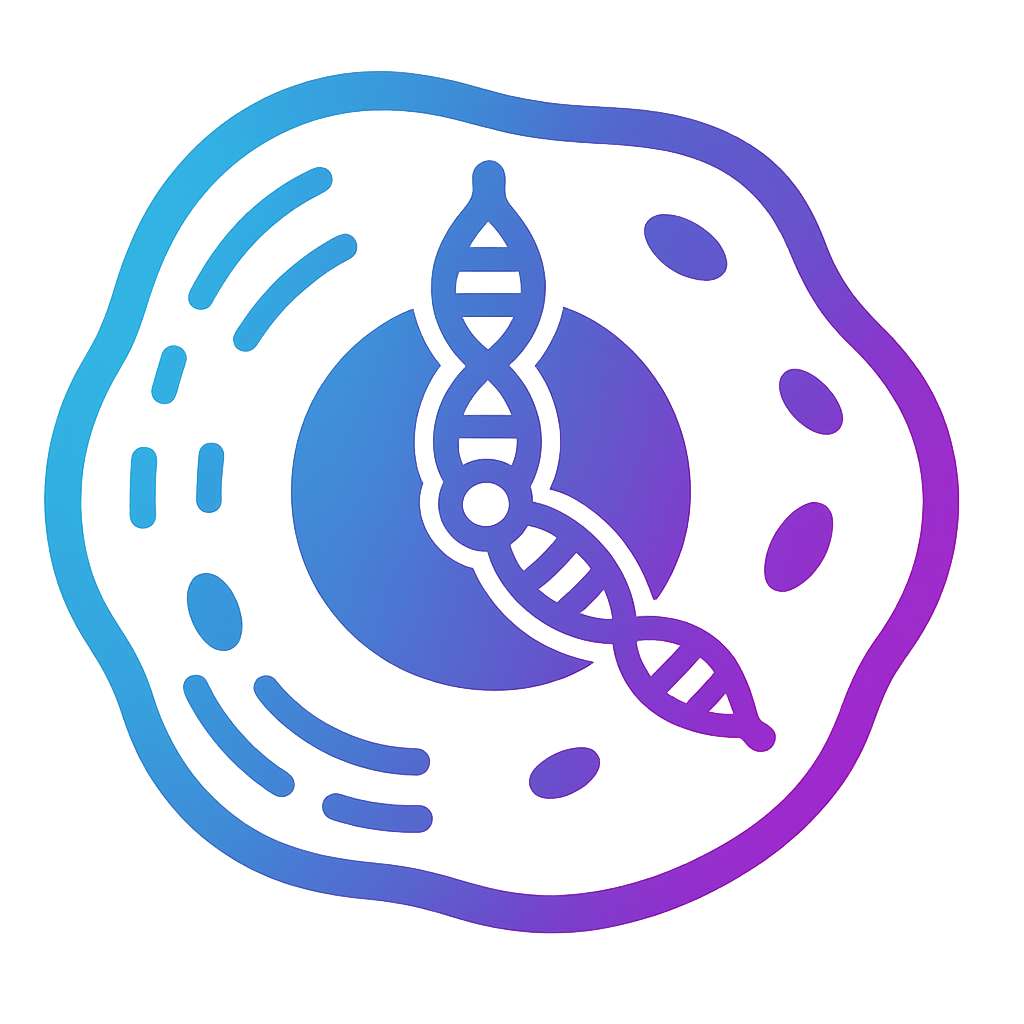
Journey Into the Biology of Time
I’ve been asking the same question for a long time:
Why do we age, and can we fight it?
This site is my way of chasing the answers and sharing the tools, insights, and science I find along the way.

Journey Into the Biology of Time
I’ve been asking the same question for a long time:
Why do we age, and can we fight it?
This site is my way of chasing the answers and sharing the tools, insights, and science I find along the way.
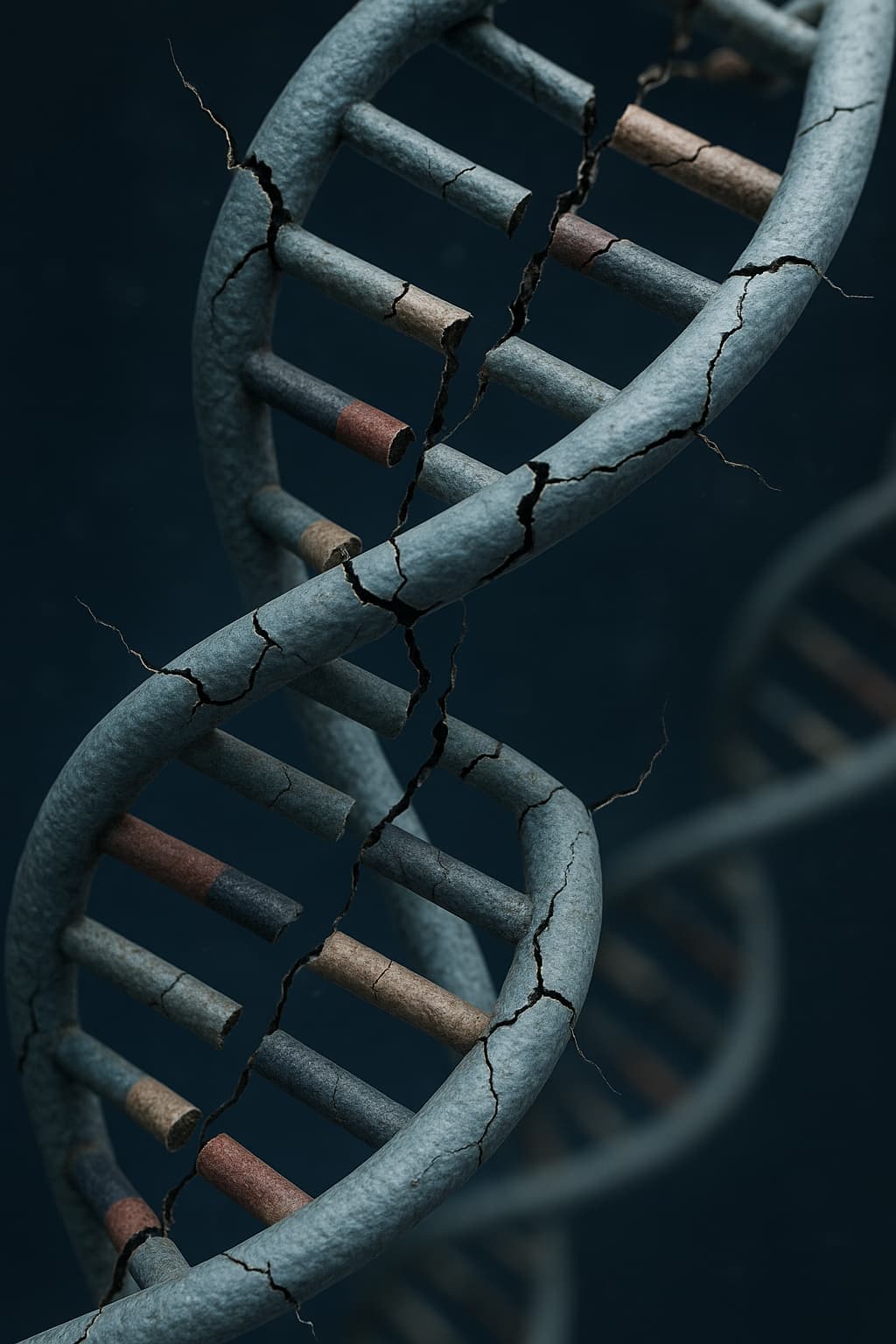
“We are all born with a perfect manuscript. But aging edits that script, one mutation at a time.”
Welcome, seeker of time’s secrets.
If you’ve found your way here, you’re probably drawn to one of the most profound truths about aging, one written not on your skin or in your bones, but deep within the silent vault of your cells.
At the heart of every breath you take, every thought you think, lies your DNA, the master script of your existence. It’s not just a static instruction manual; it’s a living code, constantly read, copied, and repaired, orchestrating the ceaseless renewal of life. And yet, from the moment you are born, it begins to fray.
DNA damage is the faintest hairline crack in your biological foundation, so small you cannot feel it, yet so powerful it shapes the arc of your entire life. Each day, trillions of microscopic assaults: sunlight, toxins, the byproducts of your own metabolism leave tiny scars in this code. Most are swiftly mended by your body’s remarkable repair machinery. But some remain. And over the decades, they accumulate, weaving a quiet pattern of decline.
This is not just a curiosity for scientists. It is one of the fundamental hallmarks of aging, a driving force behind cellular breakdown, disease, and the slow fading of vitality.
In this exploration, we’ll uncover:
To understand DNA damage is to peer into the blueprint of life itself and to see the first tremors in the architecture of youth.
The cracks may be inevitable. But the rate at which they spread? That, perhaps, is still in our hands.
Let’s look closer… before the script begins to fade.
Let’s imagine your body as a vast, living house. Inside every single room (every cell) there’s a tightly rolled-up blueprint that holds the instructions for building, maintaining, and repairing the entire structure.
That blueprint is DNA: a magnificent, double-helix spiral tucked inside the nucleus of each cell. It’s not just beautiful; it’s brilliantly efficient.
Written in a chemical language of just four letters: A, T, C, and G. DNA pairs them in exact combinations: A always pairs with T, and C with G. These simple pairs form words, sentences, and entire biological chapters, instructing your cells on what proteins to build, when to divide, and how to keep your body functioning.
But DNA isn’t just your personal instruction manual.
It’s a living record of evolution passed down from your parents, shaped by your ancestors, and shared across generations. Your genetic code is an unbroken thread, stretching back through the history of life itself. Copied, slightly edited, and handed down, it’s the molecular memory of your lineage and the operating system of your biology.
That’s why DNA damage and aging are so deeply connected.
Because when this code starts to falter, the systems it governs begin to unravel, leading to the earliest signs of cellular aging like stem cell exhaustion or cellular senescence.
And those changes?
They don’t just affect how you feel.
They shape how long and how well you live.
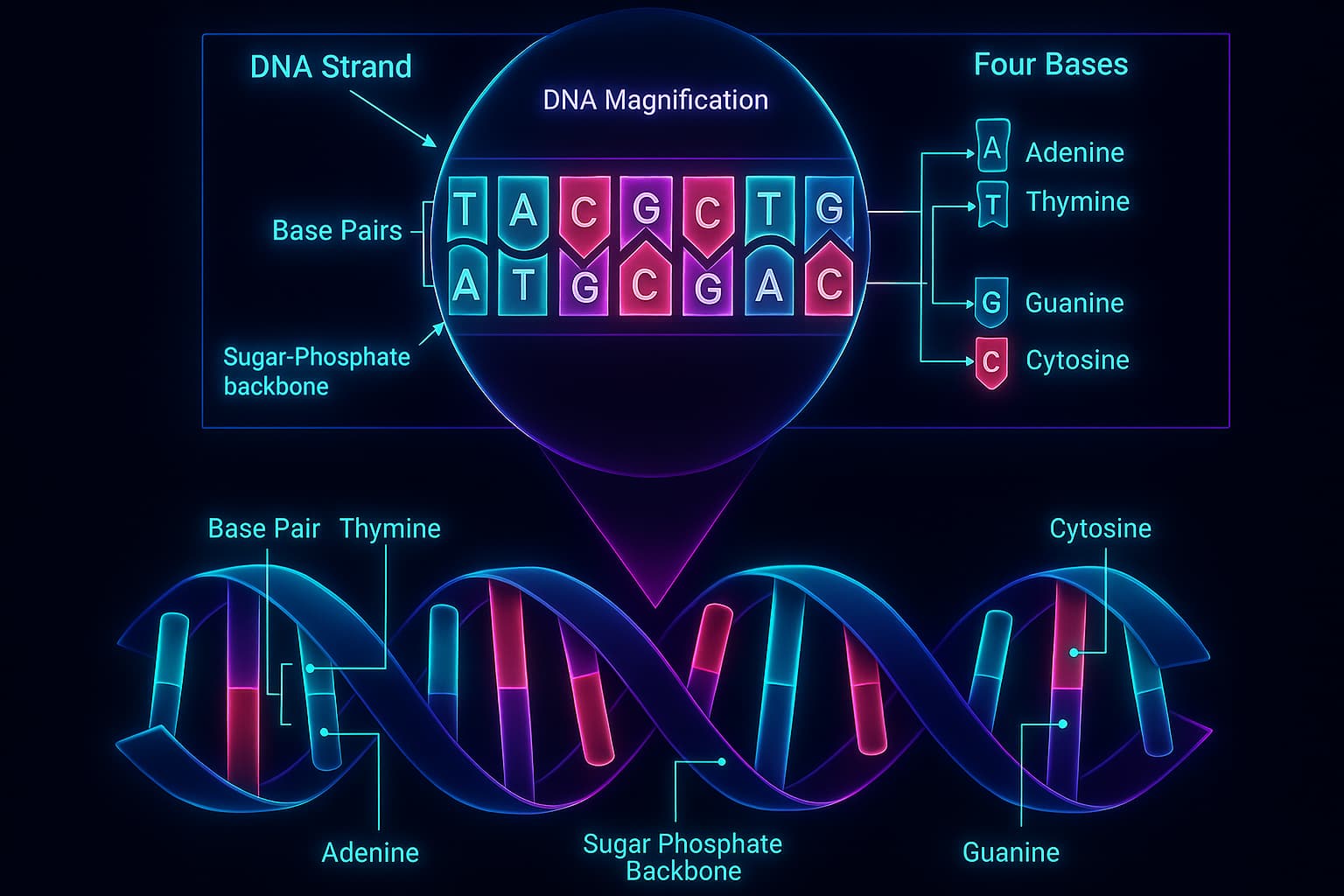
How does this blueprint work?
When your cells want to build something like a protein they call in specialized machines (and those machines are proteins themselves!).
These machines have the ability to read the DNA strand and make a protein out of its “building blocks.”
Actually, it’s a bit more complicated than that the reading machines don’t read DNA directly; they read from RNA, which is a kind of working copy of the DNA.
But maybe that’s a story for another post.
For our purposes here, it doesn’t really matter.
These machines read the DNA three letters at a time.
Why three? Because every three-letter sequence (called a codon) spells out a single amino acid and amino acids are the building blocks of proteins.
Each amino acid has its own personality:
By chaining together different amino acids in just the right order, the cell creates a protein with a unique shape and function.
In other words:
The exact sequence of letters in your DNA determines the sequence of amino acids, and that sequence determines what kind of protein gets made and what job it can do.
The proteins in your cells and their functioning and orchestration are the very essence of life itself.
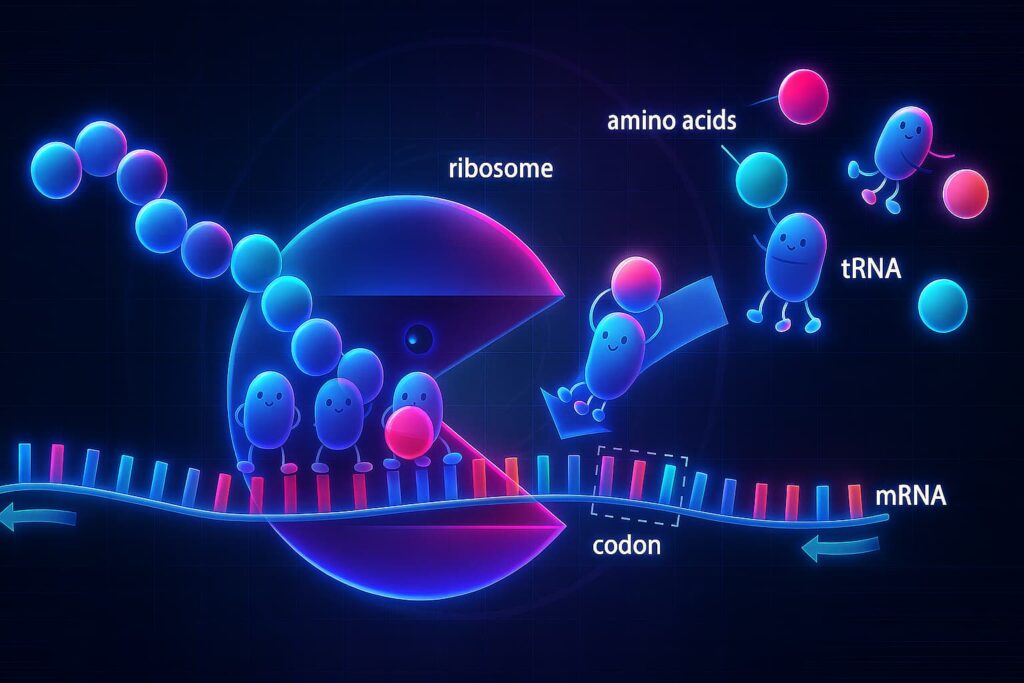
So why does precision matter?
All of this works beautifully but it depends entirely on the DNA being read correctly.
If the DNA is damaged, if a letter is changed, deleted, or misplaced the result can be like baking a cake with salt instead of sugar, or leaving out a key ingredient entirely.
If those changes become permanent in the code, they’re called mutations.
The protein may misfold, malfunction, or not work at all.
That’s why this blueprint must be protected at all costs.
It’s no wonder that when DNA damage and aging begin, things in the body can quickly get out of control. because once DNA starts to accumulate damage, it undermines every system in your body.
Even though DNA is carefully tucked away inside the nucleus like a precious document locked in a vault, it’s constantly under threat from both the outside world and processes inside our own cells.
When this blueprint becomes smudged, torn, or altered, everything starts to go wrong:
Instructions get scrambled, the builders make mistakes, and the machines they produce don’t work properly.
This is why DNA damage and aging are so closely connected: DNA damage is one of the first cracks in the system that leads to aging, making it a key hallmark of aging itself.
So what exactly damages our DNA?
1. Sunlight (UV radiation): The fading ink
Sunlight feels amazing, but ultraviolet (UV) rays can harm DNA directly.
UV light has just the right amount of energy to cause two neighboring thymine (T) bases to stick together: a problem called a thymine dimer.
Why thymine?
Thymine’s chemical structure makes it especially good at absorbing UV light, so it reacts more easily than the other DNA letters.
When two T’s stick together like this, they twist and kink the DNA strand, making it hard for the cell’s reading machines to work properly, leading to incorrect protein production and mutations.
This is one reason why too much sun exposure accelerates DNA damage and aging, speeding up skin aging and increasing the risk of skin cancer.
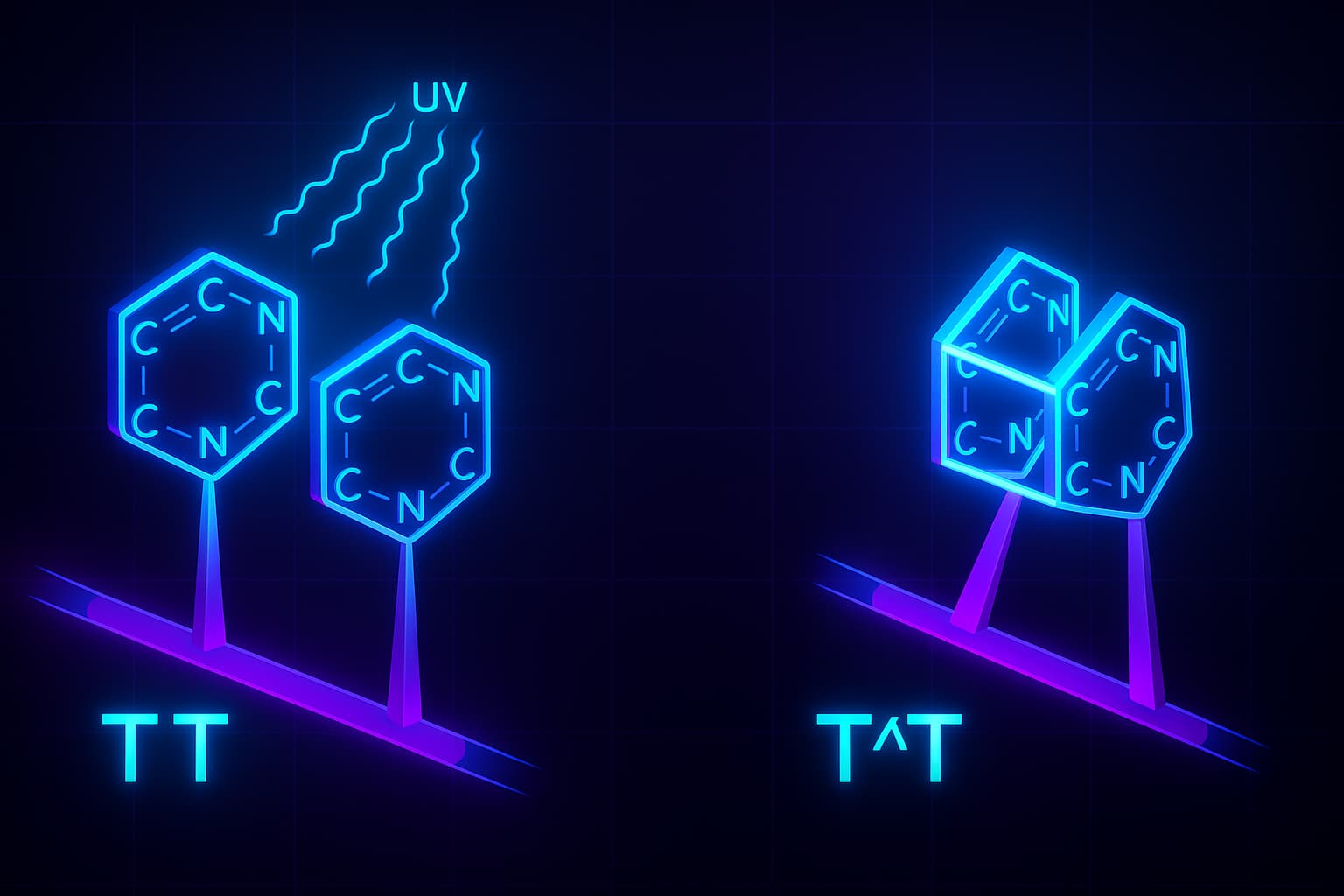
2. Oxidative stress: The corrosive rust
Inside every cell, tiny engines called mitochondria turn food into energy.
But in the process, they release reactive oxygen species (ROS): unstable molecules that behave like tiny sparks.
Why are ROS so aggressive?
Because they contain oxygen with an unpaired electron, making them desperate to grab electrons from other molecules including DNA itself.
This chemical “theft” can damage DNA bases or even break strands entirely.
This kind of slow, steady damage builds up over time and is one of the most common sources of DNA damage and aging.
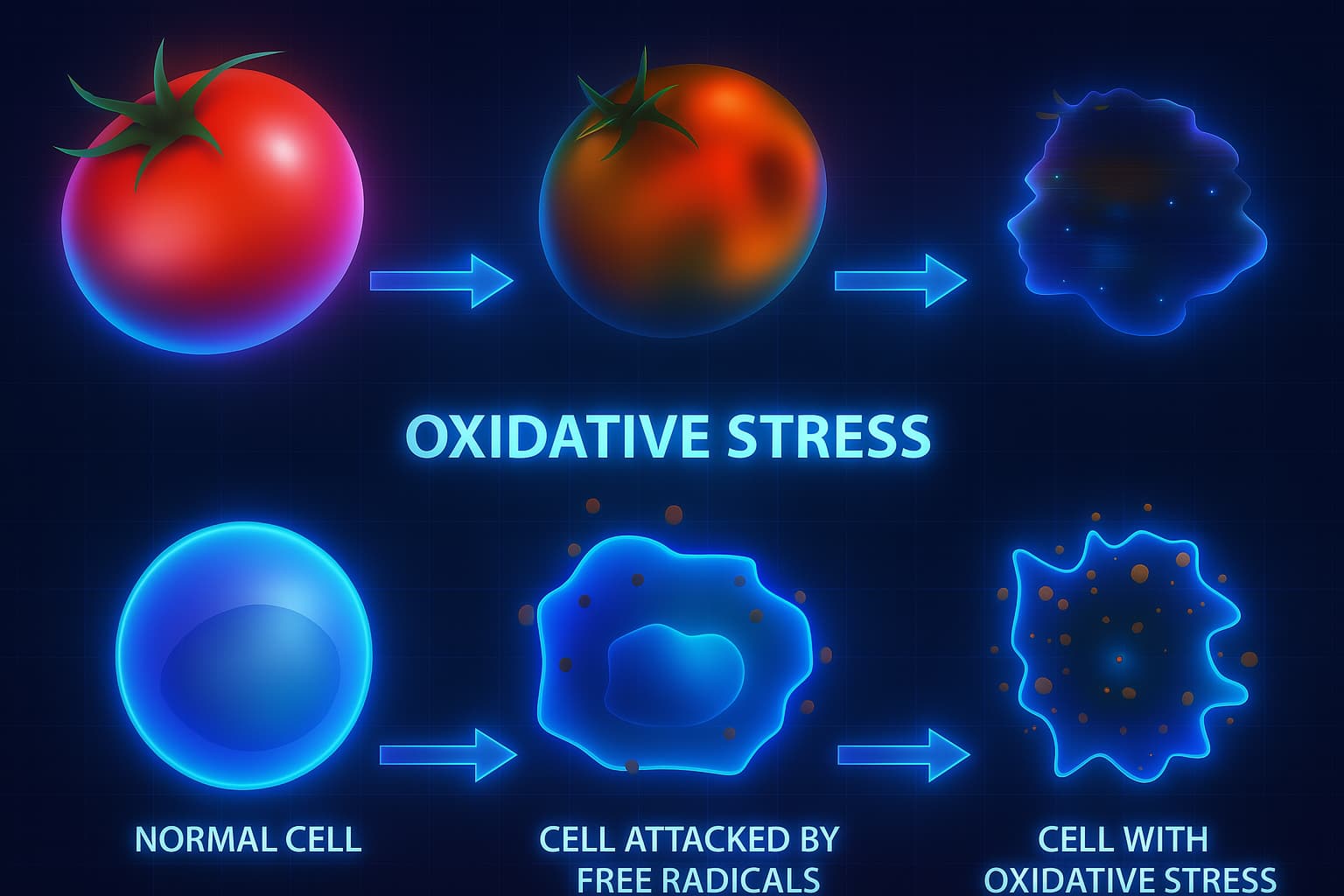
3. Toxins, pollution, alcohol, and lifestyle: The careless architect’s spills
Pollution, cigarette smoke, alcohol, processed foods. all introduce harmful chemicals that can directly attack DNA or increase oxidative stress.
For example, when your body processes alcohol, it produces acetaldehyde, a toxic molecule that sticks to DNA like a piece of annoying gum, bending and distorting it and making it harder for the cell’s reading machines to work, leaving the blueprint more prone to damage.
Many pollutants act in similar ways, they can chemically alter DNA letters or break strands altogether.
These environmental and lifestyle factors act like a careless architect spilling coffee all over the blueprint: smudging and tearing it faster than nature intended.
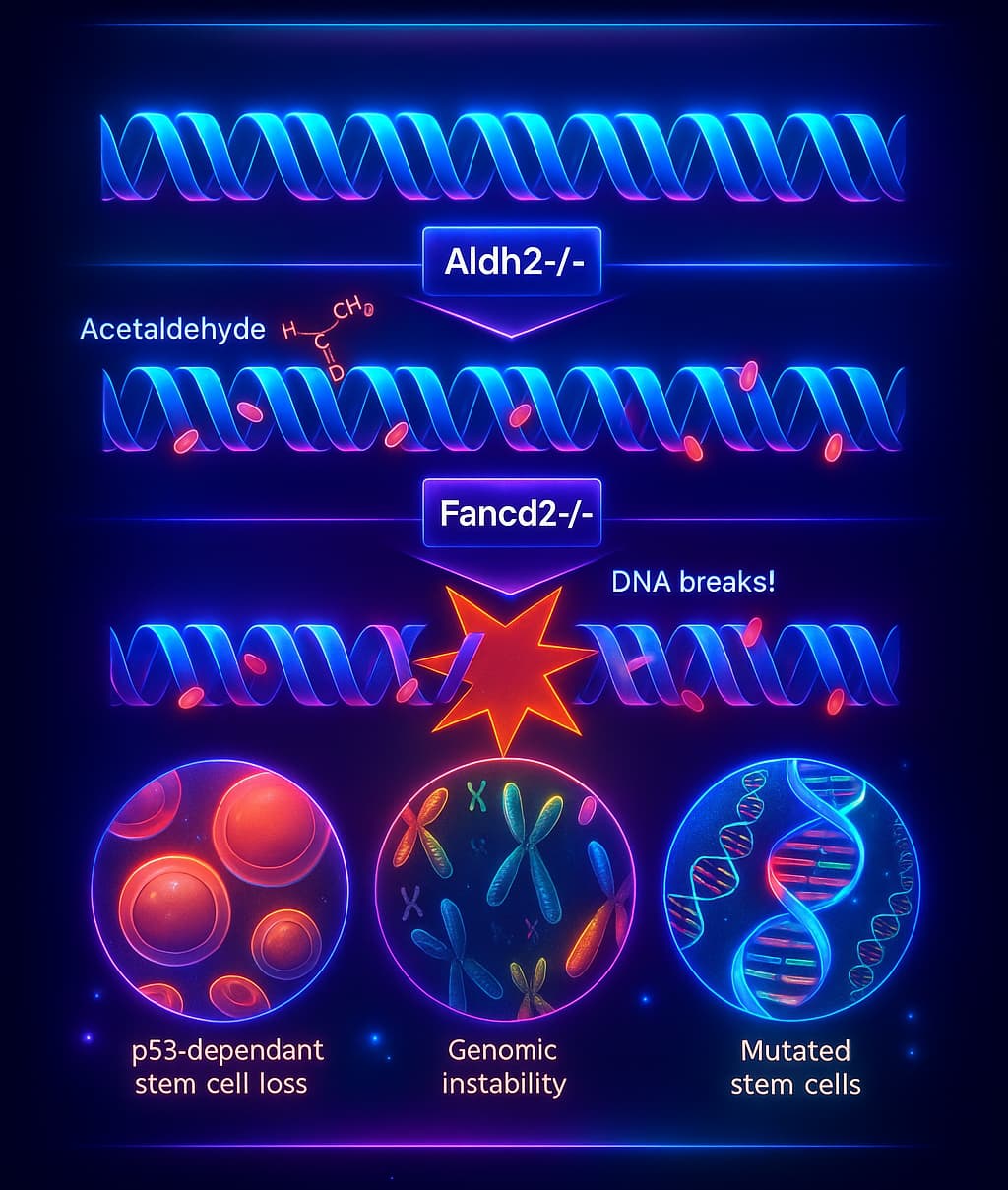
4. Copying errors: The rushed assistant
Even when protected from outside harm, DNA can still accumulate damage simply from being copied billions of times over a lifetime.
Every time a cell divides, it has to copy all of your DNA, and that’s a lot of copying!
Cells work hard to proofread, but the process isn’t perfect, tiny mistakes sneak through, and these become permanent mutations over time.
It’s like a tired assistant retyping a massive manuscript: a typo here, a missing letter there… and eventually, the errors add up.
Why is this relevant for aging?
Even though DNA is well-protected, it faces constant threats: UV rays, oxidative stress (ROS), toxins, and inevitable copying errors. all of which gradually damage the blueprint and make it harder for cells to function properly.
This is exactly why DNA damage and aging are so tightly intertwined. DNA damage is one of the first and most fundamental hallmarks of aging.
And while mutations are a driving force behind evolution, too much DNA damage inside our own bodies leads to aging, dysfunction, and disease making it a true double-edged sword.
This is exactly why it’s so important to understand these mechanisms:
If we understand them, we can work to control them and maybe even keep our DNA less damaged for longer.stand this mechanism:
If we understand it, we can try to control and engineer it and maybe even find ways to keep our DNA less damaged for longer.
Fortunately, your cells aren’t defenseless against damage.
They’re equipped with a dedicated repair crew: molecular workers that constantly scan your DNA for errors and fix them before they cause trouble.
Your cells use several specialized DNA repair pathways:
Thanks to this round-the-clock crew, most DNA damage gets patched up before it causes harm. Without them, the sheer amount of daily damage would overwhelm the system.
But even the best teams miss a few spots. And with age, repairs get slower and sloppier. Damage slips through. Errors pile up.
This decline in repair efficiency is a key driver of DNA damage and aging leading to cellular dysfunction and the slow breakdown of systems that once ran smoothly.
Supporting these repair systems isn’t just smart, it could be vital for protecting your blueprint and slowing biological aging from the inside out.
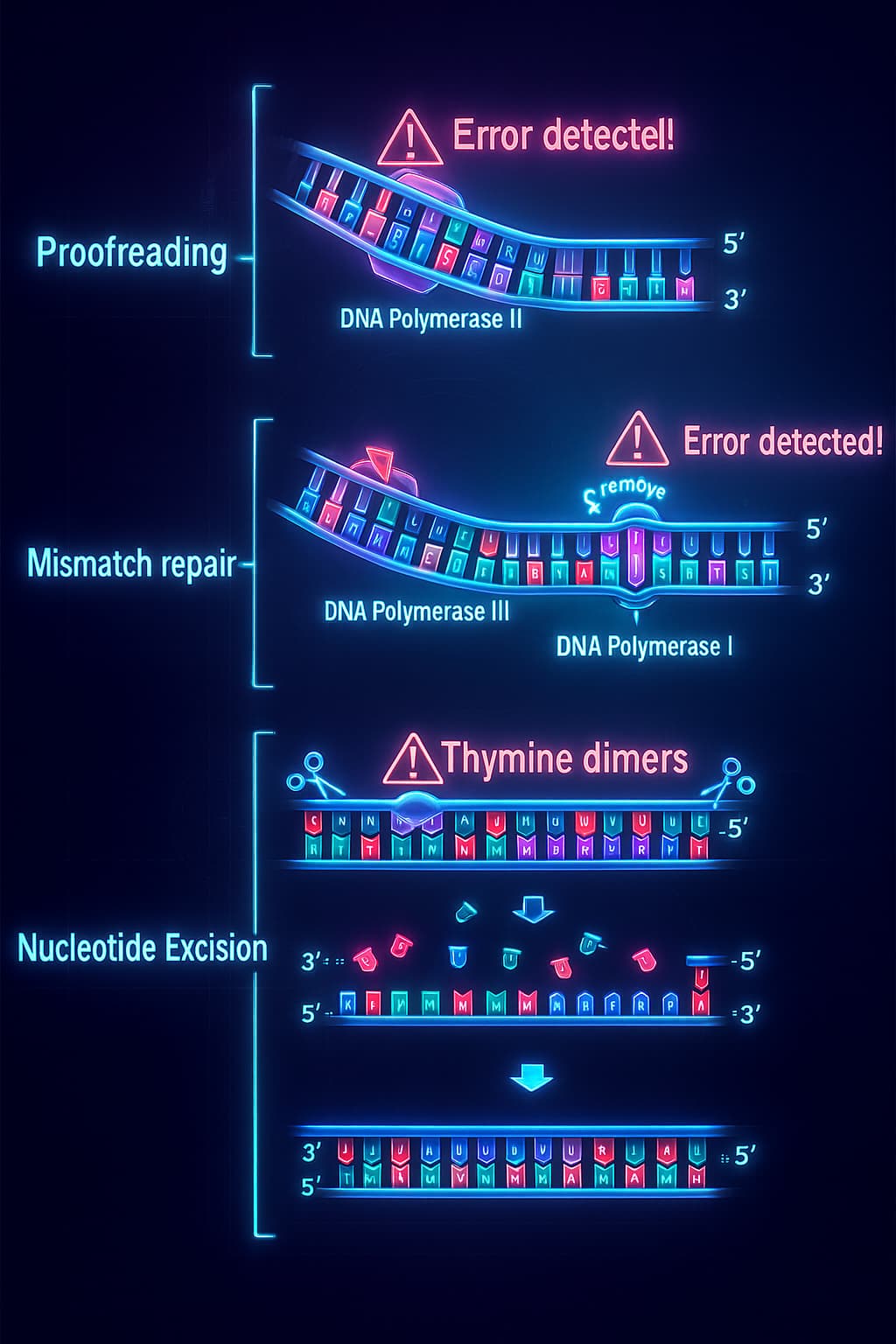
Your DNA blueprint isn’t just filed away and forgotten. it’s an active, working document.
Every day, your cells read and copy DNA thousands of times to make the proteins they need for growth, repair, and maintenance.
But when that blueprint is damaged, when smudges (like thymine dimers), tears (like strand breaks), or chemical alterations (like oxidative damage) occur, it becomes harder to read and copy accurately.
Even small errors can have big consequences, especially if they happen in genes that control critical functions like cell division, DNA repair itself, or programmed cell death (apoptosis).
Errors accumulate, and as they do, the effects ripple outward:
And there’s another layer:
As more damage accumulates, it overwhelms the cell’s repair systems, creating a vicious cycle. more damage leads to more dysfunction, which leads to even more damage.
DNA damage triggers a cascade of downstream hallmarks of aging:
This is exactly why DNA damage and aging are so tightly linked.
DNA damage is considered one of the primary hallmarks of aging because it’s where the aging process begins at the molecular level, quietly setting the stage for all the other problems that come later.
When it comes to DNA damage and aging, there are two main ways we can try to slow the process down:
The first and most immediate is lifestyle.
There’s no big secret here: most of these habits are things we all know already… but they actually work!
And maybe now, after you understand why they work, it’ll be easier to stick with them.
The second approach is to understand the biological mechanisms of the repair team and try to help them (or at least stop disturbing them like we often do!).
This is where things get really interesting, because here’s where we can boost our natural defenses with molecules and supplements to help protect our DNA.
1. Avoiding excessive sun exposure (especially without sunscreen!)
Yeah yeah, so basic, right? But it’s so freaking true!
UV light carries a lot of energy, and when it hits your skin it causes serious damage to the DNA in your cells raising the risk of cancer and speeding up DNA damage and aging.
Just wear sunscreen and don’t be reckless.
2. Eating antioxidant-rich foods to help counteract oxidative stress
Turns out, many foods like berries and leafy greens contain molecules that really know how to handle those violent ROS we talked about.
Actually, they don’t exactly fight them… more like relax them:
They basically say, “Chill, bro take my electron, don’t be so stressed!”
And with that, ROS calm down and stop causing damage.
3. Getting enough sleep
Everyone knows sleep is important but how is it connected to DNA damage and aging?
Well, it turns out that sleep is an active period for cellular maintenance, including DNA repair.
A good night’s sleep really helps protect and repair your DNA.
4. Regular moderate exercise
But wait! Didn’t we just say mitochondria generate ROS when making energy?
And during exercise, mitochondria work harder so wouldn’t that make things worse?
Actually, while acute exercise can cause temporary DNA damage, regular physical activity strengthens your DNA defenses and repair systems.
It also boosts the work of enzymes that fight ROS and calm them the heck down.
All this is nice and DNA-nerdy, but we want to take things to the next level we want to change the course of life and take our DNA protection to the limit!
If your lifestyle needs a little cellular backup, certain supplements can help reinforce your genome’s integrity, not by doing the work for your body, but by handing it the right tools and signaling molecules to keep DNA damage in check.
1. Antioxidants: The Damage Blockers
These are your first line of defense, molecules that neutralize reactive oxygen species (ROS) before they can wreak havoc on your DNA strands.
Famous players include:
2. Mitochondrial Supporters: Calming the Source
Instead of just soaking up the ROS, these supplements help your mitochondria produce fewer of them in the first place by improving their efficiency and stability.
Top contenders:
3. DNA Repair Boosters: The Mechanic’s Helpers
These compounds support the repair systems that constantly scan your genome for breaks, mismatches, and chemical injuries and fix them before they turn into bigger problems.
Key options:
4. Autophagy Activators: The Cleanup Crew
DNA repair enzymes don’t last forever. When they wear out or misfold, your body needs to recycle them. That’s where autophagy comes in: the self-cleaning system that helps refresh your cellular machinery.
Supportive compounds:
Not medical advice. Always check with your doctor before using any supplement.
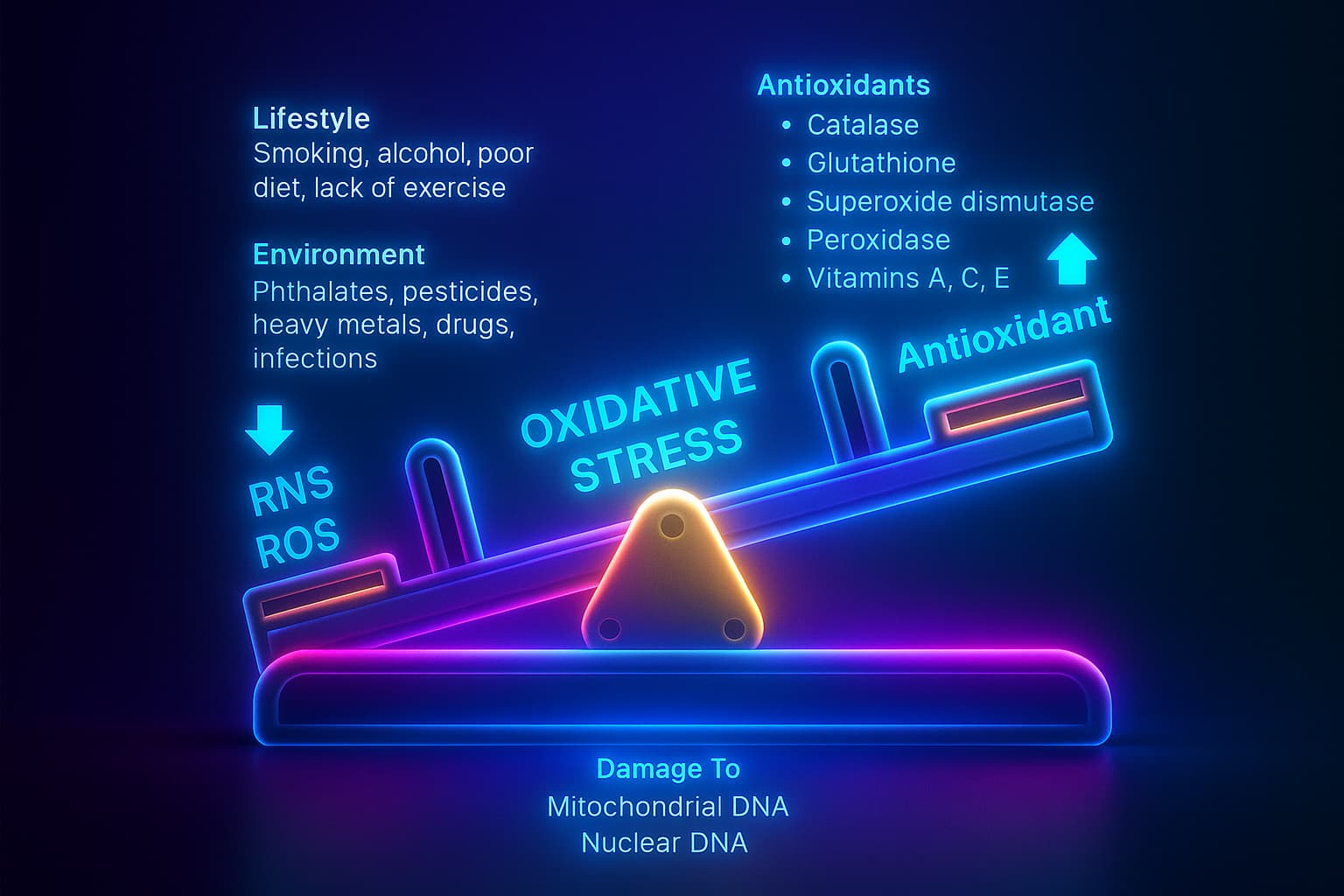
At the heart of biological aging lies a quiet but powerful force: DNA damage. Every day, your cells rely on this genetic blueprint to function, heal, and thrive but over time, that blueprint gets worn, torn, and altered.
From UV rays and toxins to oxidative stress and replication errors, your DNA is constantly under attack. And as damage accumulates, the DNA repair mechanisms that once kept everything in check start to falter. The result? Faulty proteins, cellular dysfunction, and a ripple effect that drives many of the diseases and declines we associate with aging.
This makes DNA damage and aging one of the most fundamental links in the science of longevity and one of the most promising targets for intervention.
The good news? You’re not powerless.
With a DNA-conscious lifestyle, what we call a lifestyle to reduce DNA damage. you can slow the rate of decline. That means:
And beyond habits, we now have targeted supplements for DNA protection like resveratrol, NAD+ precursors, melatonin, CoQ10, and spermidine that help boost your DNA repair mechanisms, reduce oxidative stress, and keep your cells resilient.
By protecting your DNA, you’re not just preventing damage you’re preserving your vitality, extending your healthspan, and investing in a longer, stronger future.
Because longevity starts at the source. in the integrity of your DNA.
Now that you’ve unlocked the science behind DNA damage and aging, why stop here? The aging process is a mosaic and DNA damage is just one piece.
Explore the other hallmarks of aging and see how they connect, interact, and build the bigger picture of biological aging and longevity. Pick the ones that spark your curiosity:
Each of these threads tells a different part of the aging story and each one offers a chance to intervene, repair, and thrive longer.
So… which one will you explore next?